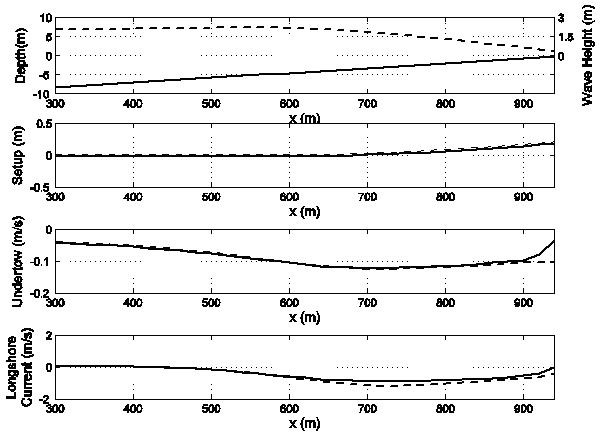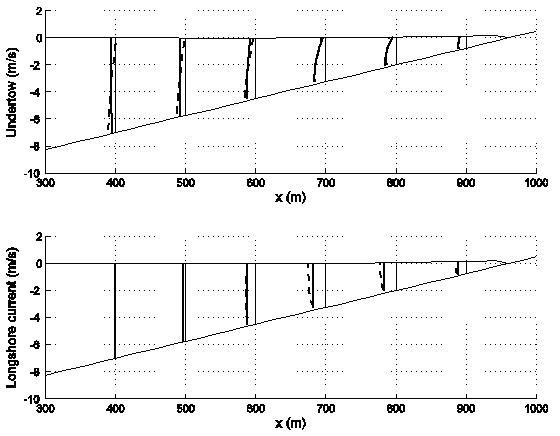Difference between revisions of "SHOREFACE CASE"
| (One intermediate revision by the same user not shown) | |||
| Line 13: | Line 13: | ||
Results are shown after the model reaches steady state. | Results are shown after the model reaches steady state. | ||
'''Output Files:''' [[media:SHOREFACE_hishis.nc | history file (shoreface_ocean_his.nc) ]]. | |||
[[Image:shoreface_fig1.jpg|thumb|850px|none|<center><b>Figure 1:</b> Plane beach test case results showing cross-shore variation of: (a) significant wave height (dashed) and bathymetry (solid); (b) wave setup; (c) depth-integrated cross shore currents; and (d) depth-integrated longshore currents. SHORECIRC results are solid lines, ROMS results are dashed lines (for panels b, c, and d). </center>]] | [[Image:shoreface_fig1.jpg|thumb|850px|none|<center><b>Figure 1:</b> Plane beach test case results showing cross-shore variation of: (a) significant wave height (dashed) and bathymetry (solid); (b) wave setup; (c) depth-integrated cross shore currents; and (d) depth-integrated longshore currents. SHORECIRC results are solid lines, ROMS results are dashed lines (for panels b, c, and d). </center>]] | ||
Latest revision as of 21:46, 3 February 2009
This test establishes a simple case of spectral waves obliquely approaching a plane beach and is described in detail in:
Haas and Warner (2009). Comparing a quasi-3D to a full 3D nearshore circulation model: SHORECIRC and ROMS, Ocean Modelling, 26, 91-103.
The case consists of spectral waves approaching a mild sloping (1/80) plane beach with an oblique angle of incidence. The wave forcing is obtained by first running SWAN separately by specifying a JONSWAP spectrum for 2 m offshore wave height with a peak period of 10 s at an angle of 10 degrees for the incoming wave field. SWAN was configured to use 90 directional bins and 30 frequency bins between 0.04 and 0.5 Hz.
The output from SWAN was made into the ROMS forcing file: Data/ROMS/Forcing/swan_shoreface_angle_forc.nc
The circulation model computes the radiation stress forcing based on the SWAN wave output. For this application there is not a feedback of the currents to the wave model. Also we neglect the contribution from the roller model. The circulation model uses a quadratic bottom stress formulation using the depth average currents.
Results are shown after the model reaches steady state.
Output Files: history file (shoreface_ocean_his.nc) .

The cross-shore profiles of water depth and SWAN computed wave height are shown in Fig. 1a.
The waves begin to decrease near x = 600 m due to wave breaking dissipation. The wave fields computed from SWAN are used in each circulation model to compute the radiation stress forcing. The depth-averaged forcing as computed by each circulation model is identical and the resulting wave setup (Fig. 1b) is very similar for the two models. Similarly the depth averaged undertow and longshore currents (Fig. 1c and d) match for the two models, except near the shoreline due to different treatments of that lateral BC.
However, the depth varying radiation stress components computed in each circulation model are different. The vertical structure of the longshore and cross-shore currents is shown in Fig. 2. Both models produce the classical undertow profile inside the surf zone. Outside the surf zone (x < 600 m), SHORECICRC is producing undertow with fairly depth uniform or a slightly increased flow near the surface in accordance with Putrevu and Svendsen (1993), whereas, ROMS is producing undertow which is still stronger in the lower part of the water column, albeit with much less curvature than inside the surf zone.
Additional description is provided in the Haas and Warner (2009) paper.
